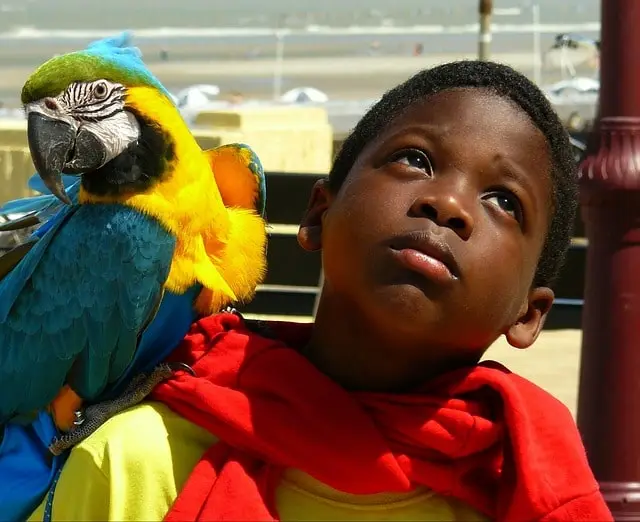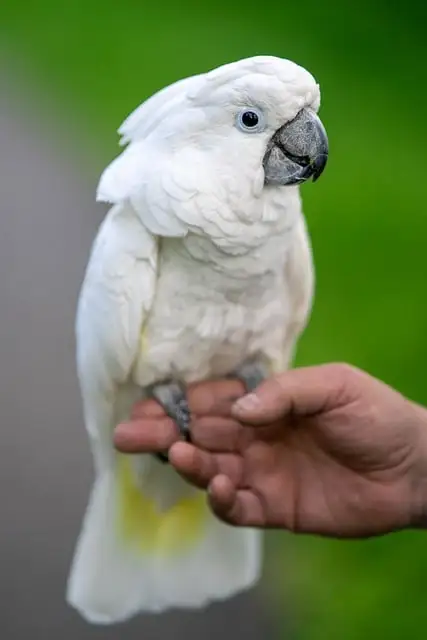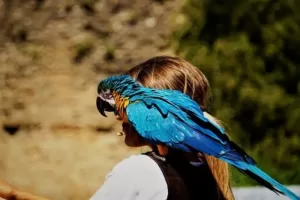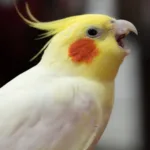I used to think how great it would be to have my parrot perched on my shoulder, just like those pirates in the movies. Little did I know, that reality might not be as cool as it seemed.
Letting your parrot climb up your shoulder comes with a few challenges. You often run the risk of receiving bites, loud screaming right in your ears, and the most dreaded of all – getting pooping on.
Now, there isn’t anything inherently wrong with letting your parrot sit on your shoulder. It is okay as long as your parrot is stepping down on command. But if your parrot is shoulder-rushing, it can be a sign that it isn’t properly trained to step up.
There can be other reasons as well why your parrot may prefer to step onto your shoulder. Parrots like to sit on shoulders because it offers them a high vantage point to observe their surroundings. They also feel safer up high as they are in a better position to avoid dangers.
Quick Navigation
Why Do Parrots Like To Sit On Shoulders?
There are several reasons why parrots prefer shoulders. They have a natural inclination to perch on the highest position. It can also be because they seek your attention or want to be closer to you. Sometimes parrots also come up to your shoulder because they are possessive. However, contrary to popular belief, parrots do not like to sit on shoulders to show their domination.

They Like A Higher Perch
Your parrot might like to be on your shoulder because it gives it a bird’s eye view of its surroundings. Parrots are instinctively drawn to higher places in their environment.
It allows them to observe their world from a point that’s less accessible to their predators. They can use it to their advantage by taking off from the scene in time when danger strikes.
And they do not feel like this just in the wild. In captivity, there are numerous threats that a parrot may believe it needs to stay on top of. It could be other pets in the house, or your neighbor’s pets. Always make sure your parrot is not doing this out of fear. If they are fearful of something, you need to calm them down.
They Feel Safer
Not only do parrots have a good vantage point at your shoulder, but they feel more secure there too. If something were to attack them, they know you’ll be there to protect them.
Interestingly, sometimes, your parrot may also do it to avoid contact with you. When your parrot climbs on your shoulder to hang out, but refuses to come down. This behavior can suggest that you do not have your parrot’s complete trust.
It does not want to be handled by you, so it crawls up your arm to avoid being on your fingers. It doesn’t mean that they don’t like you, but you may have to work a little extra to gain your parrot’s trust.
Seeking Attention
When your parrot seeks your attention, they may choose to do so by perching on your shoulder. This can happen during mealtime, when they want treats, while playing, or even when they are simply out of their cage.
Parrots may climb onto your shoulder to get closer to you, especially when you’re preoccupied with other activities. Sometimes this attention-seeking behavior can be endearing as your parrot preens you and nibbles on your ear. However, you should not encourage it.
Height Dominance In Parrots – Does It Exist?
Height dominance is a dated belief that suggests that if a parrot perches on your shoulders or anywhere near your eye level it can make them feel superior to you. This theory is based on the idea that parrots form hierarchies in the wild and the most dominant parrot of the flock perches on the highest branch.
However, this theory has long been debunked by researchers and ornithologists. We already know that parrots do not have a hierarchical system in the wild. They are dependent on each other and are used to living in flocks.
Although parrots fight each other, their motives are never hierarchical position. If that had been the case, parrots would avoid living in groups. As stated by World Parrot Trust, there is no such thing as an alpha parrot.
Should You Let Your Parrot Sit On Your Shoulder?
While it is perfectly okay to let your parrot sit on your shoulder, you should be on the lookout for potential bites and unexpected droppings.
Basically, it comes down to a matter of preference; For some people, it can be a nuisance when they’re busy, while for others, it can be a useful approach to keeping their parrots close without actually having to pick them up.
But one of the key things in having a hands-free interaction with your parrot is training them on the proper way of getting on your shoulder and stepping down when you want them to.
Ideally, you should be the one to put your parrot on your shoulder. Your parrot should easily come off your shoulder. That way you can avoid running into unexpected problems.
Also, you shouldn’t ignore if your parrot’s shoulder-rushing is rooted in unhealthy habits such as being too attached to you or being fearful of its surroundings. If you see this behavior crop up too often lately, make sure to address the real reason behind it.

How To Stop Your Parrot From Sitting On Your Shoulder?
It is fun to let your parrot climb onto your shoulder until they refuse to get off. Keeping your parrot off your shoulder is all about retraining them on how to step up and step down properly. Here are a few tried-and-true techniques you can use:
Corrective Step-Up Training
Shoulder rushing is common in parrots who are not properly trained to step up. This is why when you pick them up with your fingers, they will quickly rush up to your shoulder.
There are a few ways to correct this behavior in your parrot. At first, you should try to keep them from going up.
Gently hold their foot with your thumb. This is just to let them know that you don’t want them going up your shoulder. But don’t try to force them onto your fingers or you’ll run into problems like biting and other acts of aggression.
One other technique you could try is to make your shoulder less accessible.
When a parrot rushes on your shoulder, you cannot ask for a step-down, and if you try to, chances are, you may get nipped at. So what you can do is not let them go there in the first place.
Don’t keep your arm straight. That will make it easy for your parrot to travel to your shoulder. Position your elbow downward while offering your parrot your finger, making a V-shape with your arm. This will make your shoulder inaccessible for your parrot.
Lure Them Off Your Shoulder
Normally, when you ask your parrot to come off your shoulders, it may refuse to step on your finger, sometimes even bite. If you do this repeatedly, it can make your bird less willing to comply.
In such parrots, there is often a negative feeling associated with being picked. They know that you’re going to put them away into their cages.
So when you reward them for stepping off, it associates the action with a positive experience.
To lure your parrot off your shoulder you can either use target training or touch training, whichever one you prefer.
Let’s understand how it works. You hold a treat in one hand, at a slight distance from your parrot. Then keep the other hand between your parrot and the treat, asking them to step up. When your parrot steps onto your hand, you reward them with the treat.







